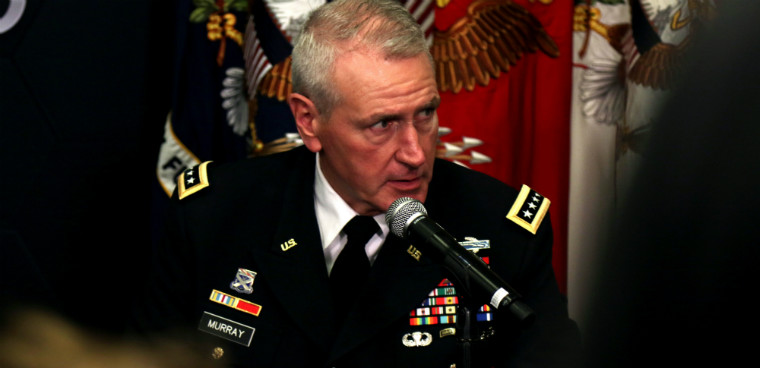Checking in with Army Futures Command

A year after standing up, Army Futures Command has hit full operating capability. Here's a quick look at three of the projects.

Army Futures Command Commanding General, Gen. John M. Murray at an Aug. 2018 press conference. (Photo credit: Sgt. Michael L. K. West/U.S. Army)
A year after its launch, the Army Futures Command has hit full operating capability. In celebration of the milestone, reporters were given a sneak peak of what the command's cross-functional teams have produced in the past year. Here's a quick look at three projects:
From video games to the battlefield
The Synthetic Training Environment team has been busy designing an all-in-one heads-up display for the tactical environment.
The Integrated Visual Augmentation System (IVAS) looks like a pair of heavy-duty goggles, but it is a single platform that can run augmented reality training, individual performance assessment and biometric applications.
IVAS project manager Col. Chris Schneider told FCW during a July 16 media event at Ft. Myer-Henderson, Va., the headset features enhanced night and thermal vision capabilities and uses augmented-reality capabilities to overlay map displays and data or simulated images in a soldier's view of the real environment. The display is also connected to a soldier's weapon sensor, Schneider said. That means a rifle's muzzle and barrel pop into view of the headset as the weapon is raised and aimed, similar to the user view in the Halo first-person shooter game. Schneider said that feature can improve shooting accuracy.
Warfighters can use it for training and rehearsing missions. It is designed to be the next generation of the Enhanced Night Vision Goggle binocular and Nett Warrior mobile device systems the Army's command and control system used for dismounted squads, Schneider said.
The team started with the commercially available Microsoft HoloLens headset and plans to integrate more sensors into the platform in October, Schneider said.
"You're bringing a lot of different things into IVAS at once. And the big deal about this is that we're using soldiers" to test it and provide feedback. They've spent 3,000 hours with it over seven months, Schneider said, with a goal of 50,000 hours by the first operational test.
Soldiers and researchers comment weekly via surveys so the feedback loop is continuous with tweaked devices rotating into the field. Changes can happen daily on the software, Schneider said.
IVAS is scheduled to be fielded across the force in the fourth quarter of fiscal 2021. In the meantime, the team has three more capability sets to complete in October, November, and July 2020, the last of which will feature the device in its final form. Schneider said he hopes to have the combat-ready version by the end of next year before heading into operational testing.
Location, location, communication
The Assured Positioning, Navigation, and Timing (APNT) team is exploring technologies to give warfighters GPS alternatives or enhancements when they operate in contested environments.
Col. Nick Kioutas, project manager for the Positioning, Navigation, and Timing said his team is updating software of the legacy Defense Advanced GPS Receiver (DAGR) system to enhance spoof protection. DAGR was written in Ada and other old software languages, which required the original programmers to be rehired to work on the program, Kioutas said. The project is targeted for completion by the end of fiscal 2020.
The team has also made progress getting satellite imagery to small troop units for situational awareness, reconnaissance and communications. The Kestrel Eye, a small satellite that is in preliminary testing, would give soldiers an aerial view covering several hundred kilometers so they could see over a mountain range to assess what's ahead, Jeri Manley, deputy director for the APNT team said. Once the satellite is in low-Earth orbit, essentially all the soldiers need are an antenna and a laptop to get access to the imagery.
"We are looking to take this proof of concept that was demonstrated with INDOPACOM (Indo-Pacific Command) and move into the prototyping phase," Manley said. The plan is to produce a constellation's worth of the small satellites and "put those in lower Earth orbit to provide persistent reconnaissance surveillance and target acquisition for soldiers."
Manley said the prototyping contract is underway in conjunction with the Air Force and Space Development Agency. The constellation should be ready in 2021 or 2022.
It's all about the network
Col. Garth Winterle, project manager for tactical radios for the Network Command, Control, Communication and Intelligence cross-functional team said his team has been experimenting with leveraging commercial 4G cellular networks and what place they have, if any, on the battlefield.
"The challenges in a tactical scenario are the architecture you need to bring with you. On an installation, you can run fiber to that tower and then your radios just have to get connectivity," he said. But in the field or on patrol in urban environments, reliable access can be harder to come by, which makes tapping into cellular networks a possible option. Spectrum complications can also come up with 4G – and ultimately will with 5G -- depending on where end users are in the world, Winterle added.
But where there's a problem, unique solutions can arise. The team is also using antenna carrying drones to expand its network capabilities.
"What these really bring is a massive ability to really extend your range, especially in rolling terrain," Winterle said. "That's a game-changer."
Radio frequencies can become distorted because of the terrain, so the drones get the antenna up high enough for a smoother signal, Winterle said. That means radios can be up to 40 kilometers away from each other and still connect thanks to the drone-enabled, mesh network.
The team has also developed an app, Black Sails, for its Nett Warrior radios that allow users to control the channels they're talking on and easily add a new radio and user to the network with the scan of a QR code.
NEXT STORY: FCW Insider: July 29






